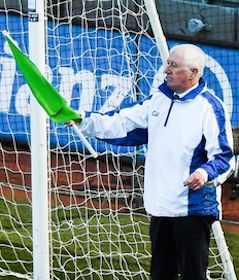Our Club
Munich Colmcilles is a Gaelic Football and Hurling club which was initially founded in 2001 by a group of Irish ex-pats in the English Garden. We have a full men's Gaelic Football team which has participated in the European-League since 2001. The ladies team first emerged in 2002 and participates in the European ladies Football tournaments which run alongside the men's tournaments. In 2007 the underage section of Munich Colmcilles was started with kids aged from 5-12 learning the skills of hurling. A vital part of the club is the off pitch activities which include social nights, Stammtisch, Strassenfests and the post tournament craic at up to 8 continental European venues over the summer.
Munich Colmcilles club is currently part of SV Gartenstadt Trudering and the club grounds are located to the south of Munich city in an area called Ostpark.
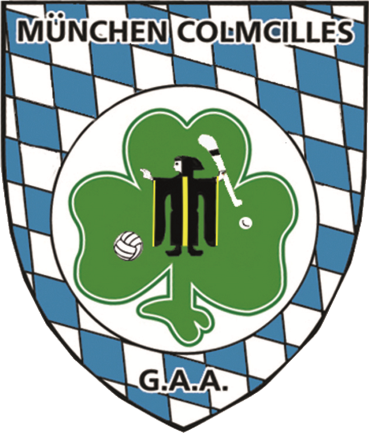
Gaelic Sports
Gaelic sports have existed in Ireland for thousands of years. Since the foundation of the Gaelic Athletic Association (GAA), the organisation of these sports has centered around Irish community life, typically "The Parish". The most popular Gaelif sports in Ireland are Gaelic Football and Hurling, but there the sports of "Court" Handball and Rounders are also Gaelic Sports organised by the GAA, with handball being especially popular within Irish communities in the USA.
For more information about the history of the GAA, check out this link: History Of The GAA
Gaelic Football
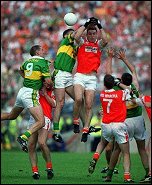
Gaelic Football can be described as a mixture of soccer and rugby, although it predates both of those games. It is a field game which has developed as a distinct game similar to the progression of Australian Rules. Indeed it is thought that Australian Rules evolved from Gaelic Football through the many thousands who were either deported or emigrated to Australia from the middle of the twentieth century.
Gaelic Football is played on a pitch approximately 137m long and 82m wide. The goalposts are the same shape as on a rugby pitch, with the crossbar lower than a rugby one and slightly higher than a soccer one.
The ball used in Gaelic Football is round and slightly smaller than a soccer ball. It can be carried in the hand for a maximum distance of four steps and can be kicked or hand-passed (which is a striking motion with the hand or fist). After every four steps the all must be either bounced or “solo-ed”, an action of dropping the ball onto the foot and kicking it back into the hand. You may not bounce the ball twice in a row. To score, you put the ball over the crossbar by foot or hand / fist for one point or under the crossbar and into the net by foot or the hand / fist in certain circumstances for a goal, the latter being the equivalent of three points.Each team consists of fifteen players, lining out as follows: One goalkeeper, three full-backs, three half-backs, two midfielders, three half-forwards and three full-forwards. The actual line out on the playing field is as follows:
Players wear a jersey with their team colours and number on the back. Both teams must have different colour jerseys. The goalkeepers’ jerseys must not be similar to the jersey of any other player. Referees normally tog out in black jerseys, socks and togs.
Goalkeepers may not be physically challenged whilst inside their own small parallelogram, but players may harass them into playing a bad pass, or block an attempted pass.
Teams are allowed a maximum of five substitutes in a game. Players may switch positions on the field of play as much as they wish but this is usually on the instructions of team officials.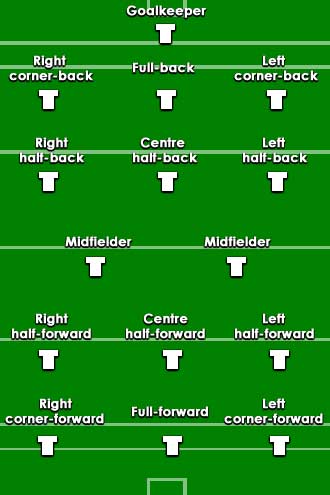
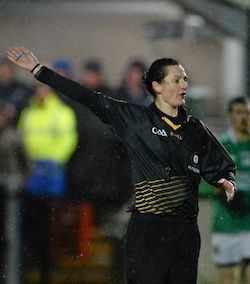
Officials for a game comprise of a referee, two linesmen (to indicate when the ball leaves the field of play at the side and 4 umpires (to signal scores, assist the referee in controlling the games, and to assist linesmen in positioning free kicks).
A goal is signalled by raising a green flag, placed to the left of the goal. A point is signalled by raising a white flag, placed to the right of goal.
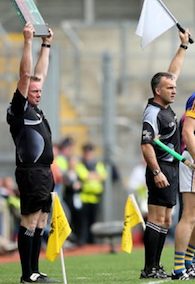
Hurling/Camogie
Hurling (or Camogie as the ladies' version is called) is a game similar to hockey, in that it is played with a small ball and a curved wooden stick. It is Europe’s oldest field game. When the Celts came to Ireland as the last ice age was receding, they brought with them a unique culture, their own language, music, script and unique pastimes. One of these pastimes was a game now called hurling.
It features in Irish folklore to illustrate the deeds of heroic mystical figures and it is chronicled as a distinct Irish pastime for at least 2,000 years.
The stick, or “hurley” (called camán in Irish) is curved outwards at the end, to provide the striking surface. The ball or “sliothar” is similar in size to a hockey ball but has raised ridges. Hurling is played on a pitch approximately 137m long and 82m wide. All athletes in hurling are amateur, so you won’t find a single job listing on an Irish Jobs website for a hurler or a referee.
The goalposts are the same shape as on a rugby pitch, with the crossbar lower than a rugby one and slightly higher than a soccer one. You may strike the ball on the ground, or in the air. Unlike hockey, you may pick up the ball with your hurley and carry it for not more than four steps in the hand. After those steps you may bounce the ball on the hurley and back to the hand, but you are forbidden to catch the ball more than twice.
To get around this, one of the skills is running with the ball balanced on the hurley To score, you put the ball over the crossbar with the hurley or under the crossbar and into the net by the hurley for a goal, the latter being the equivalent of three points. Each team consists of fifteen players, lining out as follows: 1 goalkeeper, three full-backs, three half-backs, two midfielders, three half-forwards and three full-forwards. The actual line out on the playing field is as follows:


Players wear a jersey with their team colours and number on the back. Both teams must have different colour jerseys. The goalkeepers’ jerseys must not be similar to the jersey of any other player. Referees normally tog out in black jerseys, socks and togs.
Goalkeepers may not be physically challenged whilst inside their own small parallelogram, but players may harass them into playing a bad pass, or block an attempted pass.
Teams are allowed a maximum of three substitutes in a game. Players may switch positions on the field of play as much as they wish but this is usually on the instructions of team officials.
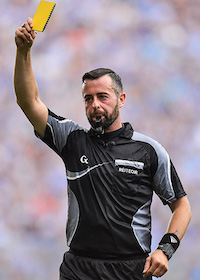
Officials for a game comprise of a referee, two linesmen (to indicate when the ball leaves the field of play at the side and 4 umpires (to signal scores, assist the referee in controlling the games, and to assist linesmen in positioning ’65’ frees).
A goal is signalled by raising a green flag, placed to the left of the goal. A point is signalled by raising a white flag, placed to the right of goal.
